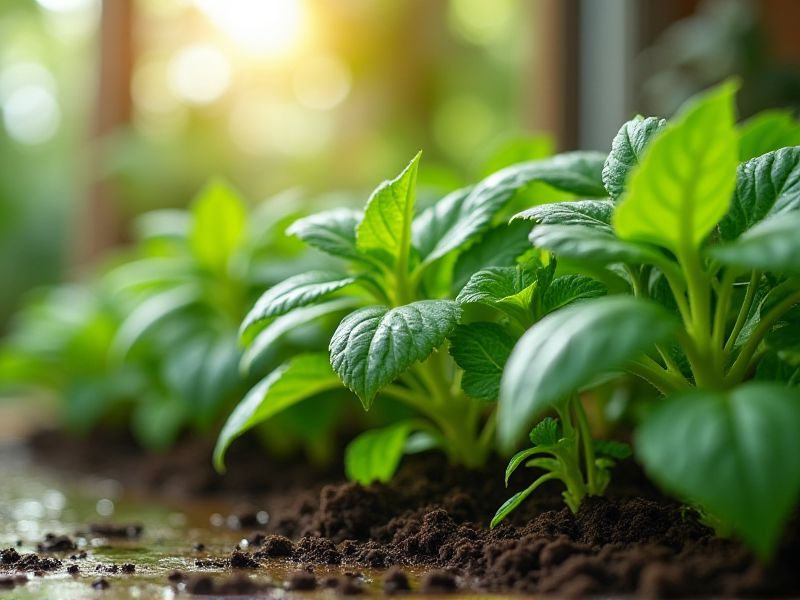
Growing vegetable plants indoors can provide fresh produce year-round, making it an excellent choice for urban gardeners. Popular options include herbs like basil and thyme, which thrive on sunny windowsills and require minimal space. Leafy greens such as lettuce and spinach grow well in containers, thriving under grow lights during colder months. Tomatoes and peppers are also suitable for indoor gardening, benefiting from bright light and ensuring a steady supply of flavor-packed fruits. By using soil or hydroponic systems, you can cultivate a healthy indoor garden that enhances your cooking and improves indoor air quality.
List of some Vegetable plants that grow indoors
- Lettuce (Lactuca sativa)
- Spinach (Spinacia oleracea)
- Kale (Brassica oleracea)
- Arugula (Eruca vesicaria)
- Radish (Raphanus sativus)
- Swiss Chard (Beta vulgaris)
- Carrot (Daucus carota)
- Green Onion (Allium fistulosum)
- Basil (Ocimum basilicum)
- Parsley (Petroselinum crispum)
Important things about Vegetable plants that grow indoors
Light Requirements
Indoor vegetable plants thrive with adequate light, typically requiring 12 to 16 hours of bright, indirect sunlight daily. Utilizing LED grow lights can effectively supplement natural light, especially during the shorter days of winter. Position your plants near east or south-facing windows to maximize their exposure to sunlight. Regularly rotating your plants ensures even light distribution, promoting balanced growth across all leaves and enhancing overall yield.
Suitable Containers
When growing vegetable plants indoors, selecting the right containers is essential for optimal growth. Opt for pots made from breathable materials like clay or fabric, which promote airflow to the roots and help avoid overwatering. Ensure that your containers have drainage holes to prevent root rot and encourage healthy plant development. Additionally, consider the size of the container; larger pots allow for greater root expansion and nutrient absorption, enabling your indoor vegetable garden to thrive.
Soil Quality
Soil quality is crucial for the success of vegetable plants grown indoors, as it directly impacts nutrient availability, drainage, and microbial activity. A blend of potting soil, compost, and perlite creates an optimal growing medium that retains moisture while providing good aeration for roots. Ensuring a balanced pH level between 6.0 and 7.0 promotes healthy growth, allowing vegetables like tomatoes and peppers to thrive. Regular testing and amending your soil with organic fertilizers can enhance fertility and support robust indoor vegetable gardening.
Watering Needs
Vegetable plants that thrive indoors typically require consistent moisture levels, with most needing about 1 to 2 inches of water per week. It's essential to check the soil moisture by inserting your finger about an inch deep; if it feels dry, it's time to water. Using well-draining pots will prevent root rot and help maintain healthy moisture levels. Consider utilizing a humidity tray or misting your plants to increase humidity, especially in dry indoor environments.
Temperature Preferences
Vegetable plants that grow indoors typically thrive at temperatures ranging from 65degF to 75degF (18degC to 24degC) during the day, while a slight drop to around 60degF to 65degF (16degC to 18degC) at night can promote healthy growth. Maintaining a consistent temperature is crucial as fluctuations can stress the plants, leading to stunted growth or pest infestations. When growing various indoor vegetables such as tomatoes, peppers, and lettuce, you should monitor environmental conditions to ensure optimal development. Utilizing a thermometer and grow lights can help you regulate both temperature and light levels, creating the perfect indoor garden environment.
Humidity Levels
Maintaining optimal humidity levels between 40% to 60% is crucial for indoor vegetable plants such as tomatoes, peppers, and herbs. High humidity can encourage fungal diseases, while low humidity may lead to dry leaf tips and stunted growth. Using a hygrometer helps you monitor the humidity in your space, ensuring a suitable environment for your plants. You can increase humidity by misting plants, placing water trays nearby, or using a humidifier to promote healthy growth.
Nutrient Management
Optimizing nutrient management for indoor vegetable plants is crucial for achieving robust growth and high yields. Essential nutrients such as nitrogen, phosphorus, and potassium, along with micronutrients like magnesium and calcium, should be carefully balanced to promote healthy foliage and fruit development. Regularly monitoring soil pH and moisture levels ensures optimal nutrient availability and prevents deficiencies or toxicities. Utilizing organic fertilizers and hydroponic solutions can enhance nutrient uptake, allowing you to grow vibrant, nutrient-dense vegetables even in limited indoor spaces.
Pest Control
Indoor vegetable plants are susceptible to various pests, including aphids, spider mites, and whiteflies. Implementing integrated pest management strategies, such as using neem oil or insecticidal soap, can effectively control these infestations. Ensuring proper air circulation and humidity levels in your indoor garden can prevent pest outbreaks. Regularly inspecting your plants allows you to catch any signs of pests early, ensuring a healthy and productive indoor vegetable garden.
Pollination Techniques
Indoor vegetable plants, such as tomatoes and peppers, often require manual pollination to enhance fruit production, as these plants may lack access to natural pollinators like bees. One effective technique involves gently shaking the flower clusters to facilitate the transfer of pollen from the male anthers to the female stigma, mimicking the action of wind. Alternatively, you can use a small paintbrush or cotton swab to collect pollen from the anthers and smear it onto the stigma of the flowers, ensuring optimal fertilization. Using these methods consistently can lead to higher yields and healthier indoor crops for your home garden.
Harvesting Strategies
When growing vegetable plants indoors, implementing efficient harvesting strategies is essential for maximizing yield and flavor. Regularly check for ripeness, as many indoor vegetables, such as tomatoes and peppers, thrive in controlled environments, allowing for faster growth cycles. Utilizing proper tools, like garden scissors or pruners, ensures clean cuts, which are vital for promoting healthy regrowth. To enhance your indoor gardening experience, consider staggering planting times to ensure a continual supply of fresh produce throughout the year.
